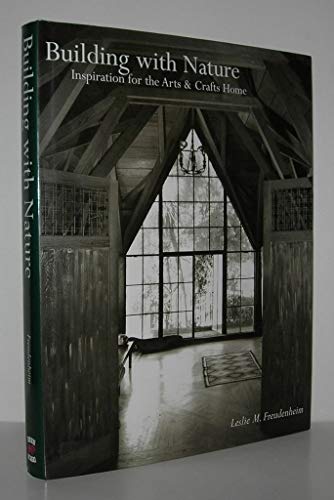Synopsis
In "Building with Nature: Inspiration for the Arts & Crafts Home" Freudenheim weaves together the lives and philosophies of William Morris, John Ruskin, Frederick Law Olmsted, John Muir, Greene & Greene, Irving Gill, Bernard Maybeck, and others with the dramatic economic, social, design and cultural changes that took place in America between 1876 and 1916. Chronicling both intellectual theory and architectural history, this ground-breaking book will appeal to general readers as well as to those enthusiastic about the Arts and Crafts Movement, its architecture and furniture.
Freudenheim demonstrates how the "simple life" manifested in the rustic architecture found in Yosemite, English cottages, Japanese barns, and Swiss chalets, became the basis for the design of the American Arts and Crafts home advocated by these pioneering thinkers. Their devotion to simplicity for both the interior and exterior design of these houses also helps to explain why they embraced plain, sturdy Mission Style furniture. Freudenheim points out how numerous individuals, both American and British, helped spread these ideas across America.
Building with Nature charts the influence of Reverend Joseph Worcester of the San Francisco Swedenborgian Church for whom the first Mission Style chair was designed in 1894. The book also shows how Worcester's friends, A. Page Brown, Willis Polk, Bruce Porter, Ernest Coxhead and Bernard Maybeck established the first American Arts & Crafts Society or Guild in 1894. Freudenheim also explores the possible role of A. C. Schweinfurth in the design of the Swedenborgian Church and quotes extensively from Charles Keeler who documented the growth of the Arts & Crafts Movement in the Bay Region.
The book shows how Gustav Stickley found California's architecture so inspiring during his four-month exploration of the state in 1904 that he thereafter promoted numerous versions of the California Arts and Crafts home in Craftsman magazine. In the August 1912 issue Stickley argued: "The value of Western architecture, locally and to the nation at large, and its widening influence upon homebuilding all over the country, are facts not to be estimated lightly...."
Describing the cross-fertilization of American and European ideas, Freudenheim also quotes visitors such as C.R. Ashbee, the English Arts and Crafts architect and founder of the School and Guild of Handicraft in London, who knew the American Arts and Crafts scene well, having traveled in the East and Midwest multiple times from 1896 on. In early 1909, Ashbee visited both Northern and Southern California and enthused: "California speaks.... Here things are really alive--and the Arts and Crafts that all the others were screaming about are here actually being produced...on the Pacific Coast."
About the Author
Leslie Mandelson Freudenheim (1941- ) has also published as Leslie M. Freudenheim and Leslie Freudenheim. She got her BA at Smith College in MA and M.A. at the Institute of Fine Arts, NYU. She interrupted work on her Ph.D. at UC.B. in Romanesque to write her first book (co-authored with Elisabeth Sussman): "Building with Nature, Roots of the San Francisco Bay Region Style." In 1971 she and Tom moved to Baltimore where she gave birth to Sascha and Adam between writing a weekly column on modern architecture, historic preservation and city planning for the Evening Sun and teaching architectural history at Goucher College. When "Building with Nature, Roots of the San Francisco Bay Region Style" was published in 1974 it sold 6,000 copies. In 1982, having moved to Washington, D.C. Freudenheim assisted with "Capital Drawings: Architectural Designs for Washington, D.C., from the Library of Congress." She published "Building with Nature: Inspiration for the Arts and Crafts Home" in 2005 (a more in depth examination of the Arts & Crafts Movement's American origins and the cult of William Morris in the S.F. Bay Area). This book was also published by Gibbs Smith. The hard cover has sold over 5,000 copies and is now out on Kindle. In 2007 she was named a Library Laureate of the San Francisco Public Library. She has delivered more than 28 lectures including at the Buffalo and San Francisco Museums of Fine Arts and at the Metropolitan Museum of Art.
Freudenheim currently lives in Manhattan & volunteers at the Metropolitan Museum of Art. Noticing that there is no short biography on Frank Lloyd Wright that is both well researched and enticing she wrote one (co-authored with Pia Abate). The pair will soon self-publish "Frank Lloyd Wright: The Man who Played with Blocks, A Short Biography for Children of All Ages."
"About this title" may belong to another edition of this title.
